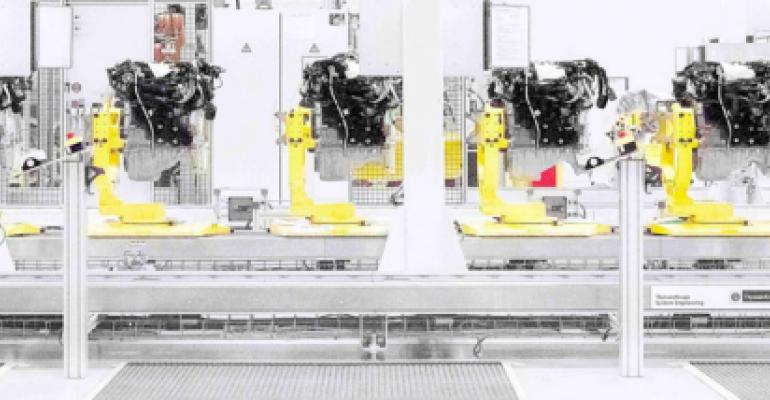MILLBROOK, U.K. – Jaguar Land Rover unveils the first gasoline version of its Ingenium engine family, claiming the flagship 300PS can achieve 15% fuel efficiency against existing powerplants.
The automaker says a host of technology has been applied to reduce energy-sapping friction and other “parasitic” losses within both the gas and diesel new-generation engines.
John Pepprell, JLR senior manager-engine planning and strategy, explains the new engines represent the latest step on the journey JLR began when it started designing and building its own powerplants in 2013.
“Our decision to go back into manufacturing our own engines was a major strategic decision and we have invested about £1 billion ($1.3 billion) or so,” he says. “We think this is a worthwhile decision to give us very competitive engines and give us the autonomy in terms of the direction we can now take the company.”
The decision also has a clear commercial strategy as JLR seeks to penetrate important global markets with the new gas engine.
“The petrol engine will be a global product going into our main markets of Europe, China and the U.S. China is very much a petrol market as is the U.S., where diesels are just beginning to make inroads, but (gasoline) remains key in these markets and we will be manufacturing it in China also,” Pepprell says.
“We have just entered mass production of the petrol engine now and we will be announcing at Paris auto show more details over which cars these engines will be going into. Depending on the models using the 296-hp version, the engine will be around 15% more efficient than the engine it will be replacing.
“We can’t talk about production volumes just yet, but suffice to say it will form a major part of our engine strategy.”
However, Pepprell is happy to list the key efficiency technologies being employed in the Ingenium family of motors. First on the list of improvements was the need to reduce friction losses within the engine using a modular design approach.
Some Diesel Technology Migrates to Gasoline Mill
“Probably the technologies of note are that the basic engine architecture carries over the main features of the diesel in terms of bore and stroke and bore spacing with the same displacement of 2.0L,” Pepprell says.
“The new key technologies being introduced are the hydraulically controlled inlet valve system to manage timing and valve lift. This is controlled through an accumulation system with the camshaft acting on a plunger to pressurize oil in an accumulation chamber and then the oil is released through a solenoid valve connected to the top of the valve. Through control of that solenoid we can manage both the time and duration of the pressure on top of the valve, effectively controlling valve timing and lift.”
The modular approach of the two engines sees them sharing a cylinder bore offset by 0.5 in. (12 mm) which “reduces the piston ring loading against the cylinder wall.”At the same time conventional bushes for camshafts and balancer shafts are replaced by roller bearings to reduce friction losses.
Other less-obvious losses within the engine also have been addressed.
“We have also reduced other parasitic losses in the oil and coolant pumps by having them both fully (computer-) variable controlled devices,” Pepprell says
“So while a conventional engine would have the pumps sized to cope with the engine at its peak performance, which leaves them 99% of the time running at full capacity when not required, by controlling the flow rate and pressure you can tune them to what the engine needs at any one time.
“Lastly, we have rapid engine warmup through the use of a split cooling system and an electronically controlled thermostat. In this way the engine reaches its operating temperature quickly, improving efficiency further.”
Pepprell says the extension of the Ingenium engine family always has been the strategy JLR has been working toward.
“This launch is (an) extension of the Ingenium family with a high-spec, high-power version of the diesel which is now 237 hp, up from 178 hp by the addition of a series-sequential twin-turbocharger system plus an uprated fuel-injection system to 2,200 bar.
“On top of that is the launch of the first petrol of the Ingenium family. We have always spoken of Ingenium being a family of engines which we launched with the diesel being our priority in Europe, but now we have extended that into a petrol engine.
“And with the twin-scroll single turbocharger, the engine will be launched in two versions offering 247 hp and 296 hp, offering comparatively high performance from a small motor.”





